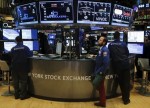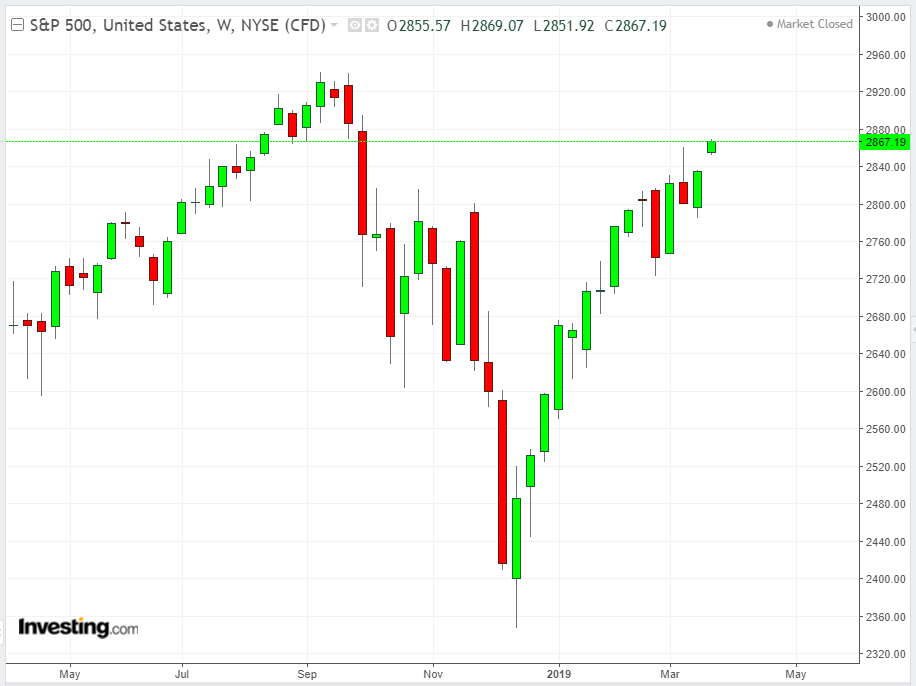
- All Instrument Types
- Indices
- Equities
- ETFs
- Funds
- Commodities
- Currencies
- Crypto
- Bonds
- Certificates
Please try another search

Market’s Q1 Rally Looks Like It Has Legs, At Least For Now

by Charley Blaine
The U.S. equity market just finished a strong start to the year, with the S&P 500 experiencing its best quarterly performance since the 2008-2009 financial crisis. On the surface, the numbers suggest the market's next move will be a serious attack on the all-time highs reached late last summer and early fall. And indeed, on the second day of Q2 trade the benchmark index closed at its highest level since October, fortifying this view.
This rally, however, isn't a continuation. Rather, it's been a rebound off a dismal fourth-quarter slump and stocks are basically back to where they were in September. Plus, there are many questions ahead that could weigh on the market.
The first-quarter rally saw the S&P 500 jump 13.07%, with the Dow up 11.15% and the NASDAQ Composite up 16.5%. The NASDAQ 100 jumped 16.6%.
While the popular mega caps sported strong gains—with Apple (NASDAQ:AAPL) up 20.4%, Facebook (NASDAQ:FB) up 27.1% and Netflix (NASDAQ:NFLX) up 33%—smaller stocks enjoyed the fun, too.
The S&P 500's biggest winner was Coty (NYSE:COTY), up 77%, followed by Chipotle Mexican Grill (NYSE:CMG), up more than 67% and Xerox (NYSE:XRX), up nearly 63%.
On the Dow, Cisco Systems (NASDAQ:CSCO), up 24.6%, was the leader, followed by IBM (NYSE:IBM), up 24.1%, and United Technologies (NYSE:UTX), up 21.1%. Boeing (NYSE:BA) finished up 18.3% for the quarter, despite the March plunge which saw its shares drop 13.3% after the second crash of the company's 737 MAX 8 jetliner.
The NASDAQ 100 Index was led by LatAm-based online retailer MercadoLibre (NASDAQ:MELI), up 73.4%, Ctrip.Com International (NASDAQ:CTRP), the China-based travel company, up 61.5% and chipmaker Xilinx (NASDAQ:XLNX), up 48.9%.
Among the worst quarterly performers on the index: Tesla (NASDAQ:TSLA), down 15.91%, on worries that vehicle sales from the electric carmaker will be pressured as tax credits expire. Kraft Heinz (NASDAQ:KHC) had the weakest showing, however, down 24.9% after disappointing quarterly results.
In terms of bragging rights for which company is now the most highly valued, Apple and Microsoft (NASDAQ:MSFT), up 16%, ended the quarter fairly close in terms of market capitalization at $895.7 billion and $904.9 billion, respectively. Amazon.com (NASDAQ:AMZN) was at $874.7 billion.
Yesterday's continued rally signals strongly that last year's all-time highs will likely be surpassed in the not-too-distant future.
The Dow is now 2.5% below its peak of 26,951.81. The S&P 500 is 2.5% under its 2,940.91 high. The NASDAQ Composite is 3.7% under its 8,133.30 peak, while the NASDAQ 100 is less than 3% of its peak of 7,700.56.
There's good reason for near-term bullishness.
Interest rates are low, which could help home sales and related purchases as well as auto sales. Manufacturing data from the Institute for Supply Management on Monday signaled continuing economic growth, boosting expectations for a strong jobs report this coming Friday. And manufacturing data from China was better than expected.
There's optimism too that the market for initial public offerings may heat and add fuel to the rally. Still, that could be tempered by Lyft (NASDAQ:LYFT), which went public at $72 on Thursday and traded as high as $88 before falling back. Shares of the ride-share company fell almost 12% yesterday, after losing 11% Monday, during the stock's second day of trading. Lyft has been burning cash as it looks to build revenue and market position. Rival Uber (NYSE:UBER), expected to go public soon, is losing even more money and investors have to decide if both are worth the risk.
As well, the surge to new highs will set up headwinds that could test the market. These include:
- How quickly the market moves past last summer's highs. Technical traders watch momentum via a variety of tools, including relative strength indices that can, and do, trigger selling automatically. You could see this at work in late March when the RSIs of the S&P 500 and NASDAQ both topped 70, a signal that prices are getting too high. Stocks pulled back a day later.
- Can the United States and China successfully negotiate a trade deal that offers more than words on paper? A real deal would be very bullish.
- Rising oil prices. Crude oil is up a third this year and Saudi Arabia is pushing to see global oil prices above $70, preferably, above $80. Retail gasoline prices in the U.S. are up nearly 20% this year, according to AAA, after falling 9% a year ago.
- Economies in Europe are contracting. The United Kingdom's inability to come up with a workable plan to exit the European Union is a threat as well.
- The potential/probability for a divisive U.S. election in 2020.
- Saber-rattling between the United States and Russia over Venezuela.
- The Federal Reserve. The U.S. central bank has said it will raise rates slowly, making President Donald Trump happy. Larry Kudlow, the president's economic advisor, thinks the Fed should cut rates. And his friend Stephen Moore, who thinks rates are too high, may soon become a Fed governor. Cutting rates too far runs the risk of fueling inflation pressures. If the economy is stronger than people think, the global bond market will ensure that no one is able to keep interest rates low.
Related Articles

Tesla (NASDAQ:TSLA) (NYSE: TSLA), the electric vehicle giant, has recently experienced a significant drop in its stock value, which has fallen nearly 45% since December. This...

Through many years of frustration among gold bugs due to the failure of gold stock prices to leverage the gold prices in a positive way, there were very clear reasons for that...

I know there is the smell of fear in the air when I see my readership double as we reach a point where weekly chart factors come into play. Up until last week, markets have...
Are you sure you want to block %USER_NAME%?
By doing so, you and %USER_NAME% will not be able to see any of each other's Investing.com's posts.
%USER_NAME% was successfully added to your Block List
Since you’ve just unblocked this person, you must wait 48 hours before renewing the block.
I feel that this comment is:
Thank You!
Your report has been sent to our moderators for review






Add a Comment
We encourage you to use comments to engage with other users, share your perspective and ask questions of authors and each other. However, in order to maintain the high level of discourse we’ve all come to value and expect, please keep the following criteria in mind:
Enrich the conversation, don’t trash it.
Stay focused and on track. Only post material that’s relevant to the topic being discussed.
Be respectful. Even negative opinions can be framed positively and diplomatically. Avoid profanity, slander or personal attacks directed at an author or another user. Racism, sexism and other forms of discrimination will not be tolerated.
Perpetrators of spam or abuse will be deleted from the site and prohibited from future registration at Investing.com’s discretion.